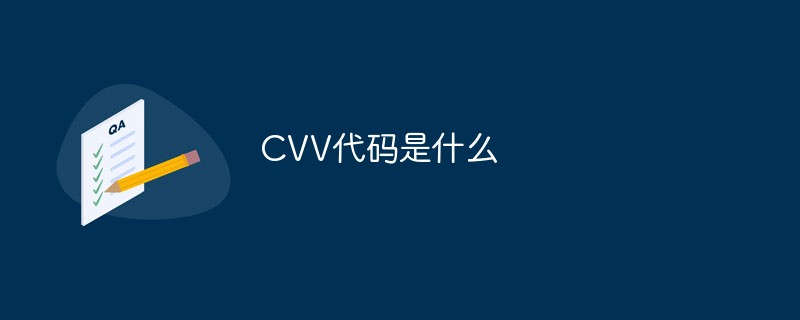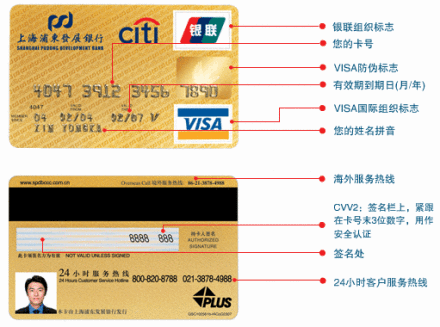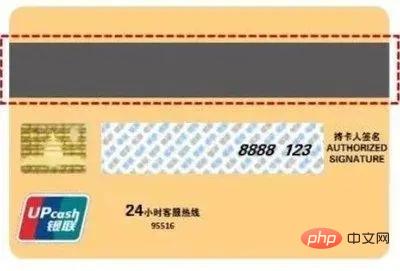What is the CVV code?
CVV refers to "security code", also called the second payment password. It is a 3 or 4-digit number generated from the card number, validity period and service restriction code. It is usually written on the back of the bank card. CVV information has always been stored in the magnetic track of the magnetic stripe bank card; the code is generated by the encoding rules and encryption algorithm of the issuing bank. During the payment process for daily consumption, if the merchant provides the last three codes to the bank, the bank will by default obtain the cardholder's authorization for the merchant and allow the merchant to conduct transactions.

The operating environment of this tutorial: Windows 7 system, Dell G3 computer.
CVV is also called the security code, also called the second payment password, Card Verification Value, and Mastercard is usually called Card Validation Code (CVC).
VISA CVV and MC CVC are both 3 or 4 digits generated by the card number, validity period and service constraint code. They are usually written on the back of the bank card. In fact, this is CVV2, not a CVV code. The generation methods of CVV and CVC are the same, but they are called differently.
CVV information has always been stored in the magnetic track of the magnetic stripe bank card. The code is generated by the card-issuing bank's encoding rules and encryption algorithm. In the payment process for our daily consumption, if the merchant provides the last three codes to the bank, the bank will by default obtain the cardholder's authorization for the merchant and allow the merchant to conduct transactions.

Verification code
CVV password verification refers to the bank card number encoding rules and magnetic stripe data used by commercial banks. The verification code (CVN) of the custom encryption algorithm is added to the format, and the relevant bank card is also called a CVN bank card.
CVV information is stored in the magnetic track of the magnetic stripe bank card. Based on the card number, track master account number, card-issuing bank logo code and other information, it is encrypted through a special encryption algorithm customized by each bank. CVKA is used in every step Technical encryption, get verification code. Since the encryption algorithms of different banks are different, some counterfeit cards illegally produced using the obtained bank card information can be identified and cannot be used when the card issuer decrypts them.
Extended knowledge:
The use of credit cards can be divided into "card transactions" and "offline transactions". In the former, the cardholder swipes the card at POS terminals such as shopping malls and supermarkets, and completes the transaction after signing for authorization. Offline transactions are common when cardholders book hotels, flights or pay online. Merchants also provide the credit card account number and last 3 codes through the POS system to complete the transaction.
Bank card security tips
First, do not record bank card information into the computer and do not have paper records, and do not record your bank card information. Tell others the card information.
Second, after losing your bank card, call the bank customer service number immediately to report the loss to prevent the card from being stolen or personal information stolen.

- ##Third, bank card is a payment and settlement tool, because it is only suitable for those who don’t know how to consume or some abnormal consumption. You can refuse payment if you have evidence.
FAQ column!
The above is the detailed content of What is the CVV code?. For more information, please follow other related articles on the PHP Chinese website!

Hot AI Tools

Undresser.AI Undress
AI-powered app for creating realistic nude photos

AI Clothes Remover
Online AI tool for removing clothes from photos.

Undress AI Tool
Undress images for free

Clothoff.io
AI clothes remover

Video Face Swap
Swap faces in any video effortlessly with our completely free AI face swap tool!

Hot Article

Hot Tools

Notepad++7.3.1
Easy-to-use and free code editor

SublimeText3 Chinese version
Chinese version, very easy to use

Zend Studio 13.0.1
Powerful PHP integrated development environment

Dreamweaver CS6
Visual web development tools

SublimeText3 Mac version
God-level code editing software (SublimeText3)

Hot Topics
 1389
1389
 52
52


